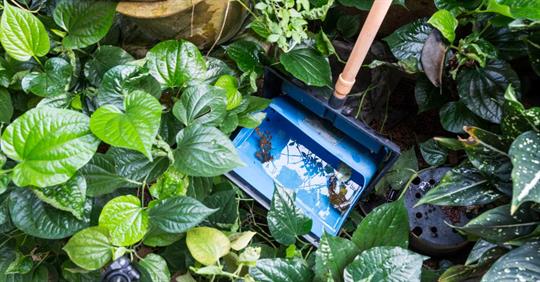Few things can spoil a beautiful day outdoors faster than a swarm of buzzing mosquitoes and gnats. These tiny pests are more than just a nuisance; they can make it difficult to enjoy your yard, garden, and other outdoor living spaces. The key to reducing their numbers is to understand where they come from.
Mosquitoes and gnats need standing water to lay their eggs; even a tiny amount can be enough for a thriving population. By identifying and managing these common breeding spots around your property, you can significantly improve your outdoor comfort.
If you're overwhelmed by mosquitoes and gnats, let us help. Get in touch with us through our online contact form or by calling (888) 708-6650 to find out how we can help you take back your yard.
The Basics of Mosquito and Gnat Breeding
Mosquitoes and gnats have a specific life cycle that requires water. A female mosquito or gnat will lay her eggs on or near a water source. These eggs then hatch into larvae, often called "wrigglers," which live in the water. After a few days, the larvae change into pupae, which don’t feed but develop into adult flying insects.
This entire process, from egg to adult, can happen in as little as four to seven days, which is why their populations can seem to explode so quickly. Since they can complete their life cycle in such a short amount of time, a small amount of standing water can lead to a big problem.
Common Breeding Grounds Around Your Home
The good news is that many of the most common breeding spots are things you can find and fix yourself. Taking the time to walk around your property with a keen eye can help you locate these hidden water sources and put a stop to the breeding cycle.
Yard and Garden Hotspots
- Potted Plants and Saucers: The saucers under potted plants are designed to catch excess water, but if left to sit, this creates a perfect environment for mosquito and gnat larvae. Emptying these saucers regularly or placing gravel in them to absorb the water can help.
- Wheelbarrows and Tarps: A wheelbarrow left upright will collect rainwater, and a sagging tarp can create a puddle. Simply turning the wheelbarrow over or ensuring tarps are taut and sloped can prevent water from accumulating.
- Bird Baths: While a lovely feature, bird baths can become breeding grounds if not maintained. Regularly emptying and refilling the water, at least once or twice a week, will disrupt the larvae’s development.
- Clogged Gutters: When gutters are blocked with leaves and debris, they can’t drain properly. This creates stagnant water channels that are ideal for breeding. Regularly cleaning your gutters is a critical step in a comprehensive pest management plan.
Hidden Water Sources You Might Overlook
It's easy to spot the obvious places, but sometimes the most effective way to reduce pests is to find the less-obvious sources of stagnant water.
- Children’s Toys: Outdoor toys like buckets, small wagons, or even a child's slide can collect water after a rain shower. A quick walk-through of the play area after it rains can make a big difference.
- Pet Water Bowls: Pet bowls left outside can also become a breeding site. It's a good idea to change the water and clean the bowl daily.
- Corrugated Drain Pipes: The flexible, ribbed design of these pipes can trap water. If your downspout empties into one of these, make sure it’s properly sloped so that water can flow all the way out.
- Decorative Items: Any decorative item that can hold water, from old tires used as garden planters to decorative fountains that aren't properly maintained, can host mosquito and gnat larvae.
Larger Water Features and Drains
While some water sources are easy to manage with a quick tip-and-empty approach, others require a more detailed strategy.
- Ornamental Ponds and Fountains: For water features you can’t easily drain, consider adding a fountain or aerator to keep the water moving. Mosquitoes prefer still water. You can also introduce mosquito fish (Gambusia) which eat mosquito larvae. However, be sure to check local regulations before adding any fish to a pond.
- Drainage Systems: Low-lying areas in your yard can collect water after a storm. Improving the grade of your yard or installing a French drain can help with drainage. Similarly, a poorly maintained septic tank or a drain field that is not working correctly can also create standing water. It's often best to consult a professional for these types of issues.
Another effective strategy for managing mosquitoes and gnats is professional treatment. Services like barrier treatments can create a zone of protection around your property. These treatments are often applied to foliage and other surfaces where adult mosquitoes rest during the day, reducing their numbers and preventing them from biting. To learn more about how this works, you can explore our pest control treatments page.
When you're dealing with pests, it can feel like a losing battle. The sheer number of potential breeding sites can seem overwhelming, but remember that every step you take to eliminate one source makes an impact. By regularly checking your property for stagnant water and managing what you find, you are actively reducing the population of mosquitoes and gnats that can affect your comfort and peace of mind.
Take Control of Your Outdoor Space with Torpedo Mosquito & Gnat
Dealing with mosquitoes and gnats can feel like a constant battle. While addressing breeding spots is a great first step, a professional treatment plan can provide a more comprehensive and lasting solution. Our team can help you identify problem areas and implement a targeted approach to reduce the number of mosquitoes and gnats around your home.
We are dedicated to helping you reclaim your outdoor living areas. If you’re ready to enjoy your yard again, contact us today through our online contact form or by calling (888) 708-6650.

